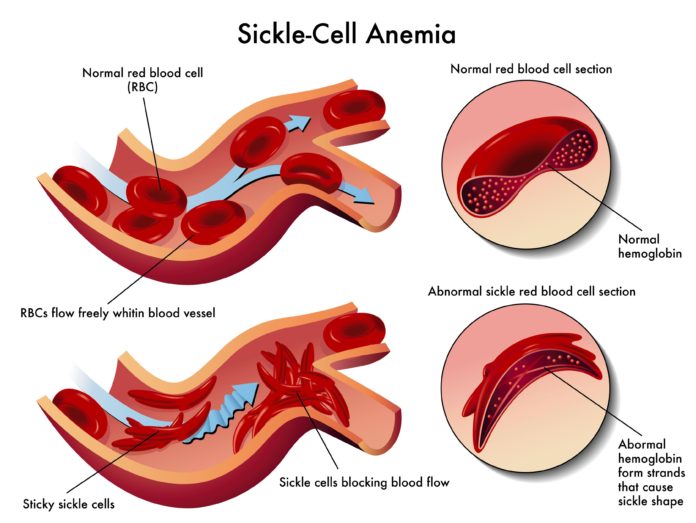Sickle cell disease (SCD) is a hereditary group of disorders that affect an individual’s red blood cells. The most common and chronic type of the disorders is known as sickle cell anemia (SCA). When the oxygen-carrying protein, hemoglobin, is abnormal in an individual (hemoglobin S), that person develops the condition. The abnormal hemoglobin causes a change in the structure of the red blood cell under oxygen tension leading to a rigid and sickle-shaped red blood cell.
In the city of Raipur in the Indian state of Chhattisgarh, Ramnath Sahu, 33, is suffering from sorrow. Kuldeep, his four-year-old son, had just been diagnosed with sickle cell disease on the previous day.
“Don’t worry my child, nothing will happen to you,” Ramvati Bai, 54, the boy’s grandmother comforted him. She was gently stroking the child outside their house which is located in Akola village, in Bemetara district. Harsh, 7, who is Kuldeep’s older brother was also diagnosed last year with the disease.
Jawahar Lal Nehru Medical College located in Raipur, the state’s capital, did a report in 2013. According to the report, 10 percent of the population of Chhattisgarh is ailing from the disease, with the native tribal inhabitants of the state being affected disproportionately.
The State Health Resource Centre in Raipur, which is run by the government released a report in December that indicated that a single tribe (the Gond tribe) had 20 percent of its population suffering from the disease.
Dr. Praveer K Chatterjee, who is the State Heath Resource Centre’s executive director, mentioned that the condition could occur more frequently among those of lower castes, for example, the Sahu and the Kurmi whose prevalence rates are 22 and 20 percent respectively.
The disease can be life-threatening, and it is for this reason that Mr. Ramnath traveled to Raipur from his village which 90km away to have him screened for it.
The abnormal hemoglobin found in the sickle cell reduces the capacity of the red blood cell to transport oxygen, causing the patients to develop symptoms of anemia, episodes of pain “sickle cell crisis”, bacterial infections such as pneumonia, swelling of the hands and feet, strokes, and also jaundice. As people age, they may develop long-term pain.
Dr. P K Patra explained the symptoms by saying, “the sickle-shaped red blood cell (RBC) face erratic movement in blood vessels.” “This stops blood carrying hemoglobin to reach cells fast enough, thus resulting in severe pain or damage to affected areas.” He added.
Dr. Patra is the director general of the Raipur Sickle Cell Institute.
If the disease is not managed at an early stage, it is fatal among children, and when treated early enough the disease can still reduce the life expectancy by a minimum of 20 years with the life expectancy in developed countries being at 40 to 60 years.
Sahu, who is clearly distressed says, “we very well know that it’s a life-threatening disease.” “But we are striving to save their lives. We would go for any possible treatment.”
The chairman of the Sickle Cell Organization of India, Dr. A R Dalla, said that not less than 10,000 children pass on as result of sickle cell disease.
The Sickle Cell Institute in Raipur, which is a present-day building with three floors, is located inside the Jawaharlal Nehru Medical College. There is a consistent number of patients who come to the facility. Muskan, 6, and Prithviraj, 2, were brought to the facility for a routine clinic visit by their parents after being diagnosed with the disease in the past. Damrudhar Jar and his wife Yashoda are their parents.
The research facility which also serves as a hospital was established in 2013 to take care of a large number of cases that are plaguing the state.
The facility conducted a sample survey of children from the time they were born to their 15th birthday and discovered those who suffered from the disease were 10 percent. The study was carried out from 2008 to 2016.
The couple (Jaal and Yashoda) come from the industrial town of Bilhai which is located 35km southwest of Raipur. Two of their children have already passed on due to sickle cell anemia.
Harsh, their son died at the age of one in 2009, and the doctors suspected that sickle cell disease might have been the cause.
On August 2016, Bharti their daughter who was 4yrs at the time complained of a severe abdominal pain. She was quickly taken to a nearby hospital, and the doctors carried out tests and discovered that she was ailing from sickle cell disease according to her father.
While he is genuinely upset, and agitated, he describes how Bharti was sustained by a life support machine for half a day in an Intensive Care Unit.
“Our daughter Bharti died in front of our eyes and we could not do anything,” he added.
Jaal brought his remaining two kids to the Sickle Cell Institute who both were confirmed of having the disease, after performing the last rites of his deceased daughter Bharti.
“Now we are worried about our two remaining kids,” he said while gazing at the sky.
The sickle-shaped red blood cell was first discovered in 1910 in a medical student in Grenada by James Herrick, who was an American physician. Sickle cell was later proven to be a molecular-genetic disease in 1949 by Linus Pauling who was an American Nobel Prize laureate.
The disease was first detected in India among native tribes in the Nilgiri Hills of South India in 1952. In the same year, the hereditary disease was diagnosed among some nomadic workers who were farmers in the tea farms of Assam state.
According to Dr. Patra, with the right management of pain relief regimens and antibiotics, those ailing from the disease can have relatively long lifespans. Catching the disease at an early stage can be a daunting task because there is no universal screening of the state’s population. Another problem is the lack of awareness about the disease that seems to be affecting many.
Both parents need to be carriers of the disease for one to have the sickle cell trait in their genetic makeup.
Due to the scarcity of government health facilities among the population many people have resorted to black magic practitioners for help in managing the disease.




